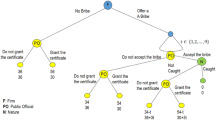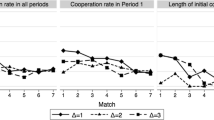Abstract
The inspection game as formulated by Tsebelis (Am. Polit. Sci. Rev. 83:77–91, 1989) has the counterintuitive implication that crime is unaffected by the magnitude of the penalty. This paper demonstrates that to attain this outcome, it is necessary to assume independence of enforcer and offender payoffs. Given correlated payoffs, the comparative statics of the equilibrium yield an inverse relationship between crime and the severity of the sanction. In an application, we enrich the framework of Tsebelis by adding corruption stages and show that this can imply such a correlation of payoffs. Another interesting finding is that harsher anticorruption measures can increase crime incentives.
Similar content being viewed by others
References
Aidt, T. S. (2003). Economic analysis of corruption: A survey. Economic Journal, 113, F632–F652.
Andreozzi, L. (2002). Oscillations in the enforcement of law: An evolutionary analysis. Homo Oeconomicus, 18, 403–428.
Andreozzi, L. (2004). Rewarding policemen increases crime: Another surprising result from the inspection game. Public Choice, 121, 69–82.
Bar-Gill, O., & Harel, A. (2001). Crime rates and expected sanctions: The economics of deterrence revisited. Journal of Legal Studies, 30, 485–501.
Bardhan, P. (1997). Corruption and development: A review of issues. Journal of Economic Literature, 35, 1320–1346.
Basu, K., Bhattacharya, S., & Mishra, A. (1992). Notes on bribery and the control of corruption. Journal of Public Economics, 48, 349–359.
Becker, G. S., & Stigler, G. J. (1974). Law enforcement, malfeasance, and compensation of enforcers. Journal of Legal Studies, 3, 1–18.
Bianco, W. T., Ordeshook, P. C., & Tsebelis, G. (1990). Crime and punishment: Are one-shot, two-persons games enough? American Political Science Review, 84, 569–586.
Bowles, R. (2000). Corruption. In B. Bouckaert & G. De Geest (Eds.), Encyclopedia of law and economics (Vol. V, pp. 460–491). Cheltenham: Edward Elgar.
Bowles, R., & Garoupa, N. (1997). Casual police corruption and the economics of crime. International Review of Law and Economics, 17, 75–87.
Cadot, O. (1987). Corruption as a gamble. Journal of Public Economics, 33, 223–244.
Chander, P., & Wilde, L. (1992). Corruption in tax administration. Journal of Public Economics, 49, 333–349.
Chang, C. C., Mjelde, J. W., & Ozuna, T. (1998). Political pressure and regulatory control. Public Choice, 97, 687–700.
Chang, J. J., Lai, C. C., & Yang, C. C. (2000). Casual police corruption and the economics of crime: Further results. International Review of Law and Economics, 20, 35–51.
Chiappori, P.-A., Levitt, S., & Groseclose, T. (2002). Testing mixed-strategy equilibria when players are heterogeneous: The case of penalty kicks in soccer. American Economic Review, 92, 1138–1151.
Franckx, L. (2004). Penalty and crime with lumpy choices. Journal of Theoretical Politics, 16, 403–421.
Fudenberg, D., & Tirole, J. (1991). Game theory. Cambridge: MIT Press.
Funk, P. (2005). Governmental action, social norms, and criminal behavior. Journal of Institutional and Theoretical Economics, 161, 522–535.
Garoupa, N. (2008, forthcoming). An economic analysis of criminal law. In A. Hatzis (Ed.), Economic analysis of law: A European perspective. Cheltenham: Edward Elgar.
Garoupa, N., & Jellal, M. (2007). Further notes on information, corruption and optimal law enforcement. European Journal of Law and Economics, 23, 59–69.
Garoupa, N., & Klerman, D. (2004). Corruption and the optimal use of nonmonetary sanctions. International Review of Law and Economics, 24, 219–225.
Graetz, M. J., Reinganum, J. F., & Wilde, L. (1986). The tax compliance game: Toward an interactive theory of law enforcement. Journal of Law, Economics, and Organization, 2, 1–32.
Harris, M., & Raviv, A. (1978). Some results on incentive contracts with applications to education and employment, health insurance, and law enforcement. American Economic Review, 68, 20–30.
Hirshleifer, J., & Rasmusen, E. (1992). Are equilibrium strategies unaffected by incentives? Journal of Theoretical Politics, 4, 353–367.
Holler, M. J. (1993). Fighting pollution when decisions are strategic. Public Choice, 76, 347–356.
Holler, M. J. (1997). Fighting pollution when decisions are strategic: A reply. Public Choice, 98, 465–466.
Levitt, S. D., & Miles, T. J. (2007). Empirical study of criminal punishment. In A. M. Polinsky & S. Shavell (Eds.), The handbook of law and economics (pp. 455–495). Amsterdam: North Holland.
Marjit, S., & Shi, H. (1998). On controlling crime with corrupt officials. Journal of Economic Behavior and Organization, 34, 163–172.
McCabe, K. A., Mukherji, A., & Runkle, D. (2000). An experimental study of information and mixed-strategy play in the three-person matching-pennies game. Economic Theory, 15, 421–462.
Mookherjee, D., & Png, I. P. L. (1995). Corruptible law enforcers: How should they be compensated? Economic Journal, 105, 145-159.
O’Neill, B. (1987). Nonmetric test of the minimax theory of two-person zerosum games. Proceedings of the National Academy of Sciences, 84, 2106–2109.
Pogrebna, G. (2005). Do people play Nash? A natural experiment on strategic voting in The Weakest Link. Paper presented at the XIth Spring Meeting of Young Economists, Sevilla.
Polinsky, A. M., & Shavell, S. (2001). Corruption and optimal law enforcement. Journal of Public Economics, 81, 1–24.
Polinsky, A. M., & Shavell, S. (2007). The economic theory of public enforcement of law. In A. M. Polinsky & S. Shavell (Eds.), The handbook of law and economics (pp. 403–454). Amsterdam: North Holland.
Rose-Ackerman, S. (1975). The economics of corruption. Journal of Public Economics, 4, 187–203.
Rose-Ackerman, S. (1999). Corruption and government: Causes, consequences, and reform. Cambridge: Cambridge University Press.
Schrag, J., & Scotchmer, S. (1997). The self-reinforcing nature of crime. International Review of Law and Economics, 17, 325–335.
Tirole, J. (1994). The internal organization of government. Oxford Economic Papers, 46, 1–29.
Toma, M. (1989). Will bounty-hunting revenue agents increase enforcement? Public Choice, 61, 247–260.
Tsebelis, G. (1989). The abuse of probability in political analysis: The Robinson Crusoe fallacy. American Political Science Review, 83, 77–91.
Tsebelis, G. (1990a). Are sanctions effective? A game-theoretic analysis. Journal of Conflict Resolution, 34, 3–28.
Tsebelis, G. (1990b). Penalty has no impact on crime: A game-theoretic analysis. Rationality and Society, 2, 255–286.
Tsebelis, G. (1993). Penalty and crime: Further theoretical considerations and empirical evidence. Journal of Theoretical Politics, 5, 349–374.
Van Rijckeghem, C., & Weder, B. (2001). Bureaucratic corruption and the rate of temptation: do wages in the civil service affect corruption, and by how much? Journal of Development Economics, 65, 307–331.
Walker, M., & Wooders, J. (2001). Minimax play at Wimbledon. American Economic Review, 91, 1521–38.
Yaniv, G. (2001). Revenge, tax informing, and the optimal bounty. Journal of Public Economic Theory, 3, 225–233.
Author information
Authors and Affiliations
Corresponding author
Rights and permissions
About this article
Cite this article
Friehe, T. Correlated payoffs in the inspection game: some theory and an application to corruption. Public Choice 137, 127–143 (2008). https://doi.org/10.1007/s11127-008-9317-7
Received:
Accepted:
Published:
Issue Date:
DOI: https://doi.org/10.1007/s11127-008-9317-7




